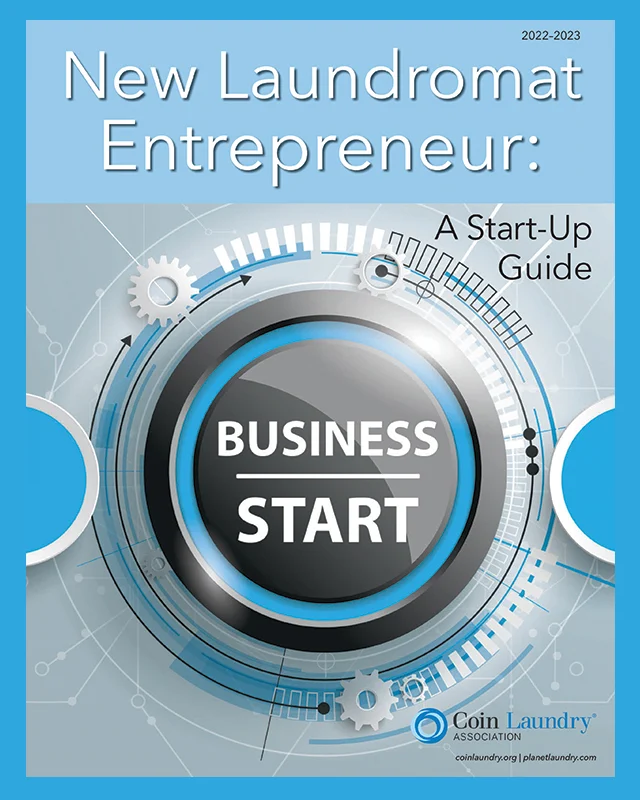In today’s laundromat industry, one truth holds across every market, model and mission: success requires more than just machines.
Today’s operators must choose business models strategically, execute consistently, and lead with intention. Some lean into simple, scalable self-service. Others build around service offerings like wash-dry-fold, pickup and delivery, or commercial laundry.
“You can’t just think of yourself as a landlord with machines,” said Brian Wallace, CEO of the CLA. “This is a retail service business. You’re not just offering machines — you’re offering an experience, and increasingly, a suite of services. And every layer adds complexity.”
Operators like Florida-based Ron Jansen, Jr., Houston-based Rob Maes, Ohio-based Randy Roberts and Florida-based Natalie Matus know that complexity well. Their paths — and their business models — are different. But all are rooted in discipline, learning, and a deep understanding of what makes laundromats work.
Model 1: Self-Service
Ron Jansen, Jr. was 8 years old when he saw his uncle stacking nickels and dimes on a table after collecting coins from the laundromat he owned. That seemingly small moment created a lasting impact on Ron.
From that moment, Ron was hooked on the concept and never let it go. He went on to become a Dexter distributor before he and wife Shari started S&R Ventures Unlimited and opened Supermatt. The Florida-based family business is now 24 stores strong and employs more than 100 people.
“The self-service model remains the most focused and scalable way to run a laundromat business,” said Ron. “We made a very conscious decision to do one thing exceptionally well: serve walk-in customers.”
For Ron, that all added up to a need to make sure every location is clean, that the machines work, payment is simple, and pricing is competitive. “Once the self-service experience has been perfected across the board then it might make sense to explore other services,” he said. “But not before.”
To do that, Supermatt is focusing heavily on tightening standard operating procedures, refining store branding and investing in its people. “Operators who put time into the systems behind the scenes, things like training, safety, store standards, team culture … they can avoid costly issues and create value,” said RJ Jansen, who officially stepped into a leadership position in the family business in 2021. “It’s not always glamorous work, but it pays dividends in guest satisfaction, employee retention, and overall performance.”
Self-service is not without its challenges. According to Ron, key among them is labor. “The top five challenges facing laundromat operators today are labor, labor, labor, labor and labor,” he said. “Finding and retaining reliable team members has become more difficult in recent years and Supermatt is seeing the business impact of the immigration enforcement, not only in the labor pool but also with foot traffic in some of our more diverse communities.”
Fluctuating foot-traffic can be a challenge in the self-service model. As can the energy and effort required to continue to drive new traffic to your stores. “Self-service is the bread and butter,” said Natalie Matus of First Class Laundry. “But that traffic fluctuates and if we can be doing wash-dry-fold or commercial customers during that time, we’re making the most of our investment and we’re closer to consistent revenue.”
Model 2: Wash-Dry-Fold
Wash-dry-fold (WDF) can be a strong way to add revenue to your business. Whether from increased turns from individuals leveraging your stores for their business or for you creating another customer audience for you to bring in revenue that may have not been there otherwise.
But like any model, you need to have proper systems and structures in place to keep yourself protected and to ensure positive customer experiences.
For Rob Maes of Express Laundry Center in Houston, he calls it laundry protocol. “You have to double down on process: weighing loads, documenting contents, and training staff to follow the same steps every time,” he said. “This protects the customer and the business.”
When Maes had first opened his laundromats, he had a customer who was convinced that the laundromat had lost six pairs of expensive jeans. “Our intake and exit weights matched, but the customer was incredulous. I politely asked the customer to do me a favor and go home and double check, and to please let me know,” said Maes. “He found his jeans.”
According to Wallace, roughly two-thirds of today’s laundromats offer Wash-Dry-Fold services. “This can be a great service,” he said. “But it does have some things people need to make sure they consider. As volume grows, operators can run into issues with staffing, competing with self-service customers for machines during peak hours and limited storage space that you typically see in traditional laundromat design.”
Model 3: Pickup and Delivery
For some, the next evolution of Wash-Dry-Fold is Pickup and Delivery. This model offers the most potential scale but also high operational risk.
Wallace sees the same trend industry-wide. “Operators are excited about growth, but delivery requires infrastructure: scheduling tools, service windows, CRM follow-up, vehicle management,” he said. “That’s not something you figure out on the fly.”
For Matus, Pickup and Delivery was actually her starting point. After a corporate career, Matus found inspiration in her son’s summer camp laundry and launched a pickup and delivery service from her mom’s laundromat.
“I never had anything to do with the laundromat,” she said. “It was just a thing my mom did in retirement.”
The business took off. “The first summer I put it out there on social media and got a website and a logo and just marketed it like crazy,” she said. “We did probably 100 bags that first summer and I knew that we were onto something.”
In the beginning, she was doing it on her own but quickly realized she wouldn’t be able to scale that way and that she needed to invest in infrastructure and people. “I started getting busy enough that I couldn’t be the one doing the driving, and the laundry or I would just be running around all day,” she said. “So, I hired two employees to help, and we hired two drivers and we’re doing great.”
For Matus, the keys for pickup and delivery come down to two things: logistics and people. “We have a lot of great people to help us,” she said. “Logistics is the biggest thing because time management and route management can be really tough. We’ve got a great system that helps us manage that.”
After almost 3 years, Matus is now looking at additional opportunities as she has grown her pickup and delivery business. The natural transition was into picking up small to medium-sized commercial accounts. And now, she’s going bigger. “We have landed a few larger clients, and I’d really love to get to the point where we have a warehouse with folding machines and presses and all of that.”
When Randy Roberts left a successful corporate career in the middle of the pandemic, he wasn’t looking for a cushy landing. He was looking for a challenge—and maybe a change of pace.
He found both in laundry.
Today, Roberts co-owns Columbus Express Laundry in Columbus, Ohio, a business that has rapidly evolved into a logistics-driven powerhouse focused on commercial and residential pickup and delivery. But that growth didn’t happen by accident—it’s the result of intentional moves, constant learning, and a refusal to be boxed in by the industry’s traditional playbook.
“We’re not strictly commercial. We’re opportunistic,” Roberts said. “I want to be a generalist. Whatever I find, I want to be able to hunt it, skin it and win it.”
That mindset has helped Columbus Express Laundry scale quickly. Just a few years ago, the company operated two public-facing laundromats. Today, one of those locations is closed to the public, and a new 4,400-square-foot processing facility is under construction to keep up with commercial demand.
Roberts joined the business after leaving a corporate sales career, quickly identifying commercial opportunities others were missing.
“My cousin had an attendant doing drop-off, but it wasn’t growing like he thought it could,” Roberts said. “I did some research, some prep work, learned the point-of-sale systems and route management—and when the calls started coming in, they were mostly large commercial customers.”
That first big contract? A luxury glamping company renting out high-end tents—white linens, comforters, mattress pads and all.
“They were dropping off semi truckloads of laundry and we weren’t smart enough to say no,” Roberts said with a laugh. “We made a ton of mistakes. Too many staff, not enough folding tables—but we muscled through it and learned a lot.”
The lesson stuck: the bigger the bag, the better the math.
“Fifty percent of our driver time is spent picking up 81 percent of the revenue,” he said. “If I can pick up a 200-pound load instead of ten 20-pound loads, I’ve just created a more efficient route.”
Model 4: Commercial Laundry
When Maes started his laundromats on the front end of the Great Recession he needed to figure out ways to cash flow the business, and quickly.
So, he took the seats out of the family minivan and started seeking out commercial accounts. “We were undercapitalized, the nation had the highest unemployment rate in 20 years and all these other things going on,” Maes said. “We had to focus on keeping these new businesses afloat however we could.”
But his first commercial customer actually came from paying close attention to the customers coming through his self-service doors.
“Our very first commercial account was a salon and spa nearby. I noticed the masseuses coming in consistently with a large number of towels that were all the same color,” he said. “You could see the grimaces on their faces, and I just smiled and walked up to one of them and said we could do that for you if you want.”
But commercial work brought its own challenges. “We had one client who had employees who weren’t using the bags we provided for them and instead put laundry in garbage bags and then throwing them next to trash bins,” Maes said. “Some bags were taken to the dump by mistake and of course who took the blame? Us.”
His fix: clear SOPs and custom-labeled bags. “Every client gets color-coded bags, pickup logs, and tracking,” he said. “That’s how you stop small problems from becoming big ones.”
Roberts is quick to point out that when it comes to pickup and delivery and commercial laundry, it isn’t just a laundry business, it’s a logistics operation.
“Our product is laundry, but the real business is routing, scheduling, and systems,” he said. “Without good systems, we wouldn’t have made it this far.”
Columbus Express runs a mix of vehicles—minivans, cargo vans and box trucks—depending on customer size. One stop might be a single residential bag. Another could be bins full of linens for a hotel or medical facility.
“Two days ago, we thought a commercial stop would take 30 minutes. It turned into two hours and a second truck because they didn’t have their rolling carts,” Roberts said. “If you don’t have systems that let you flex routes and respond in real time, you’re sunk.”
Those systems extend beyond routing. Customer communication, invoicing, reporting—even damage and stain tracking—are all built into a flexible tech stack that enables scale. The team tracks inventory for some customers, flags damaged items, and even reports back with monthly summaries to help them reorder.
“If you’re doing everything right and nobody knows it, you’re doing it wrong,” Roberts said. “We’re constantly communicating so our customers know what we’re doing for them.”
